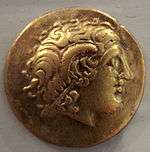Tricastini
The Tricastini (or Tricassis) were a Gallic tribe dwelling near present-day Saint-Paul-Trois-Châteaux, in the Tricastin region, during the Roman period.[1][2]
Name
They are mentioned as Trikastínoi (Τρικαστίνοι; var. Τρικαττίνοι, Τριστακηνοὶ, Τρικαστηνοὶ) by Ptolemy (2nd c. AD).[3][4] They were also known as Tricassis during the Roman period, a variant of Tricasses, a name borne by another Gallic tribe attested further north in the Champagne region.[1]
The meaning of the name Tricastini, attested by the 1st c. AD (Pliny), is unclear.[1] The Gaulish suffix tri- certainly means 'three',[1][5] and the second may element -castini is probably an alternative spelling of -cassis.[1][6] The meaning of -cassis / -casses is less certain, possibly 'hair, hairstyle', perhaps a particular warrior coiffure, or 'tin, bronze (helmet?)'.[7] Based upon such interpretations, the translation 'the three-braided ones', 'those who have three braids', has been proposed for Tricastini / Tricassis.[6]
The city of Saint-Paul-Trois-Châteaux, attested as civitas Tricastinorum ca. 400 AD ('civitas of the Tricastini', civitate Tricastrina in 1136, probably evolving into Sanctum Paulum *Tri-castrum in the Middle Ages,[note 1] then Sainct Pol Trois Chasteaux in 1545) is named after the tribe.[1] The insertion of an epenthetic r that changed Tricastini to Tricastrini, attested by the 12th century, caused a semantic reinterpretation of the name, leading eventually to the modern French Trois-Châteaux ('three-castles'; Latin Tria-Castra).[8]
Geography
The Tricastini dwelled on the west bank of the Rhône river, in a mountainous region, between the Cavari, the Vocontii and the Segovellauni.[2]
In the 2nd century AD (Ptolemy), their capital was Noviomagus, likely the modern city of Saint-Paul-Trois-Châteaux.[2] In the first century AD, it was referred to as Augusta Tricastinorum.[8]
References
Footnotes
- Attested as Sancti Pauli (vel Sancti Restituti Trigastinensi) in 993, as San Paul ca. 1180, and as Sanctum Paulum Tricastinensem in 1338.[8]
Citations
- Nègre 1990, p. 157.
- Polfer 2006.
- Ptolemy. Geōgraphikḕ Hyphḗgēsis, 2:10:7
- Falileyev 2010, p. entry 3989b.
- Delamarre 2003, p. 301.
- Delamarre 2003, p. 109.
- Delamarre 2003, pp. 109–110.
- Nègre 1990, pp. 157–158.
Bibliography
- Delamarre, Xavier (2003). Dictionnaire de la langue gauloise: Une approche linguistique du vieux-celtique continental (in French). Errance. ISBN 9782877723695.CS1 maint: ref=harv (link)
- Falileyev, Alexander (2010). Dictionary of Continental Celtic Place-names: A Celtic Companion to the Barrington Atlas of the Greek and Roman World. CMCS. ISBN 978-0955718236.
- Nègre, Ernest (1990). Toponymie générale de la France (in French). Librairie Droz. ISBN 978-2-600-02883-7.CS1 maint: ref=harv (link)
- Polfer, Michel (2006). "Tricastini". Brill’s New Pauly.CS1 maint: ref=harv (link)
